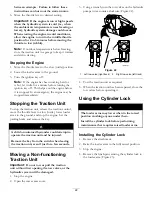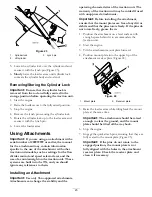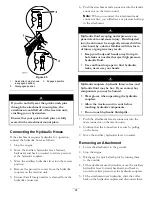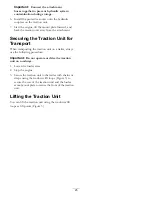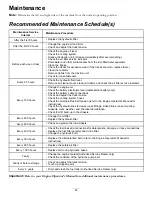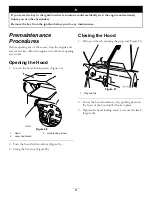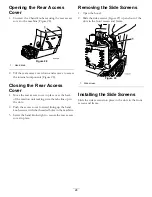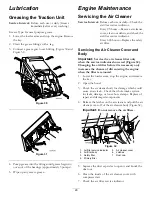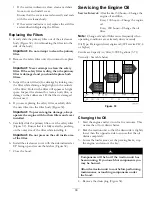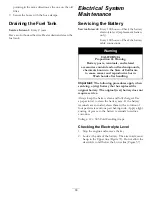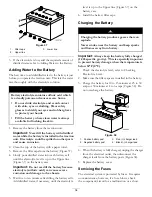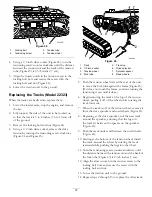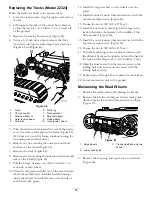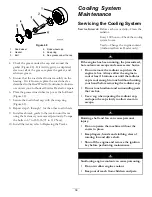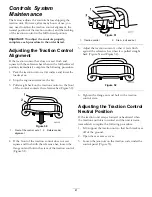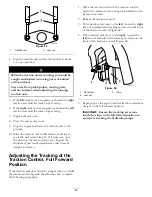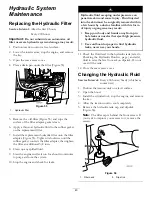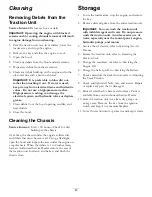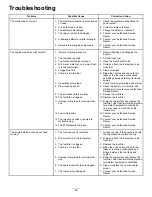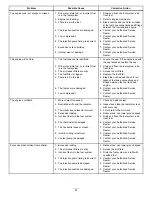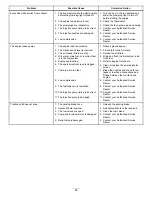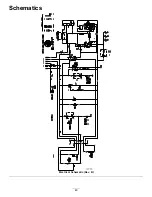
2
3
1
G003794
Figure 37
1.
Filler caps
3.
Lower line
2.
Upper line
3. If the electrolyte is low, add the required amount of
distilled water; refer to Adding Water to the Battery.
Adding Water to the Battery
The best time to add distilled water to the battery is just
before you operate the traction unit. This lets the water
mix thoroughly with the electrolyte solution.
Battery electrolyte contains sulfuric acid which
is a deadly poison and causes severe burns.
•
Do not drink electrolyte and avoid contact
with skin, eyes or clothing. Wear safety
glasses to shield your eyes and rubber gloves
to protect your hands.
•
Fill the battery where clean water is always
available for flushing the skin.
1. Remove the battery from the traction unit.
Important:
Never fill the battery with distilled
water while the battery is installed in the traction
unit. Electrolyte could be spilled on other parts
and cause corrosion.
2. Clean the top of the battery with a paper towel.
3. Remove the filler caps from the battery (Figure 37).
4. Slowly pour distilled water into each battery cell
until the electrolyte level is up to the Upper line
(Figure 37) on the battery case.
Important:
Do not overfill the battery because
electrolyte (sulfuric acid) can cause severe
corrosion and damage to the chassis.
5. Wait five to ten minutes after filling the battery cells.
Add distilled water, if necessary, until the electrolyte
level is up to the Upper line (Figure 37) on the
battery case.
6. Install the battery filler caps.
Charging the Battery
Charging the battery produces gasses that can
explode.
Never smoke near the battery and keep sparks
and flames away from battery.
Important:
Always keep the battery fully charged
(1.265 specific gravity). This is especially important
to prevent battery damage when the temperature is
below 32°F (0°C).
1. Check the electrolyte level; refer to Checking
Electrolyte Level.
2. Make sure the filler caps are installed in the battery.
3. Charge the battery for 10 to 15 minutes at 25 to 30
amps or 30 minutes at 4 to 6 amps (Figure 38). Do
not overcharge the battery.
1
2
3
4
G003792
Figure 38
1.
Positive battery post
3.
Red (+) charger lead
2.
Negative battery post
4.
Black (-) charger lead
4. When the battery is fully charged, unplug the charger
from the electrical outlet, then disconnect the
charger leads from the battery posts (Figure 38).
5. Replace the battery cover.
Servicing the Fuses
The electrical system is protected by fuses. It requires
no maintenance; however, if a fuse blows, check
the component/circuit for a malfunction or a short.
34
Summary of Contents for 22319
Page 7: ...Slope Indicator 7...
Page 49: ...Schematics G007388 Electrical Schematic Rev B 49...
Page 50: ...Hydraulic Schematic Rev A 50...
Page 51: ...Notes 51...



